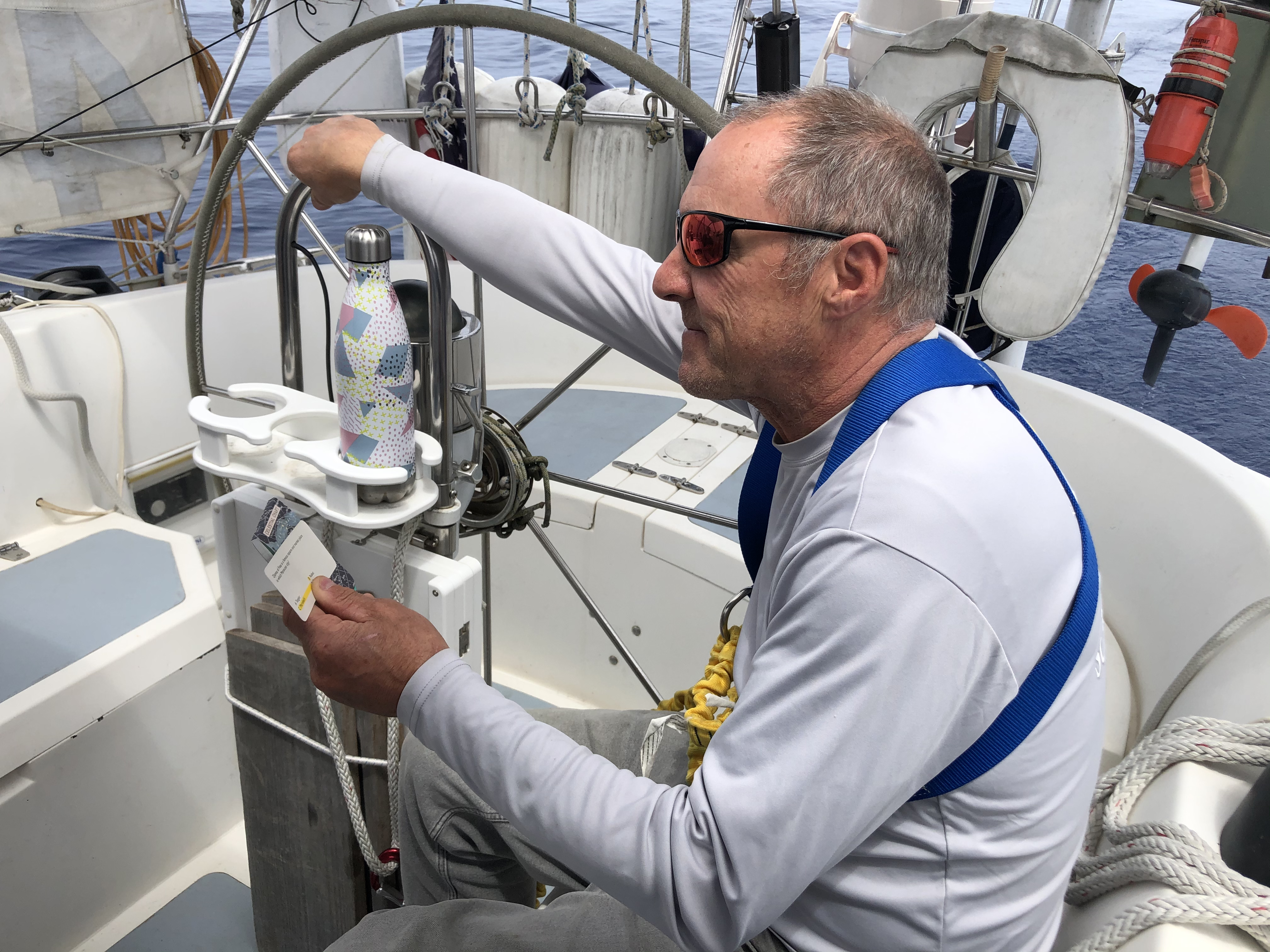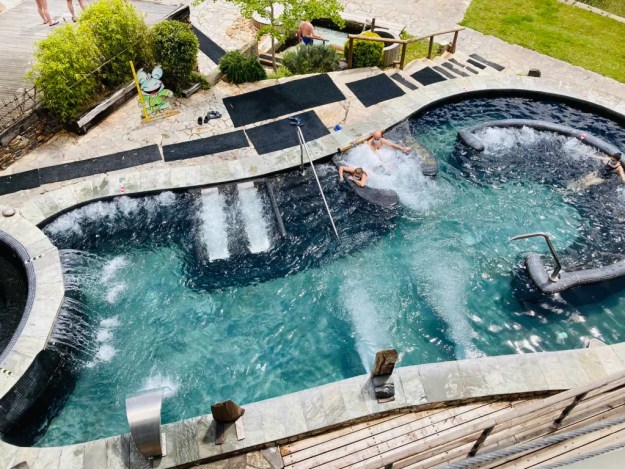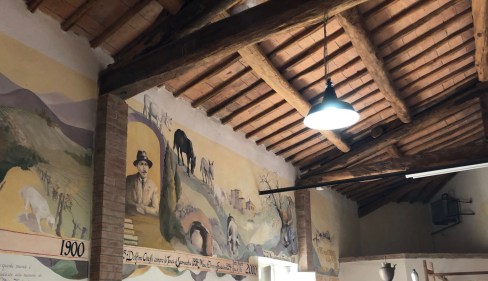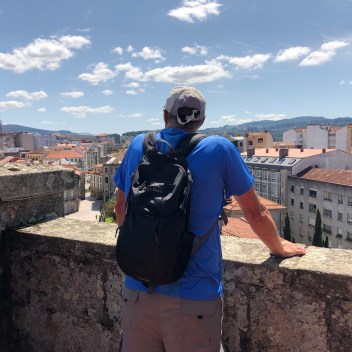UPDATE #13
June 12
Day 24

Steve: History at sea … and chocolate on a stick.
Our intrepid travelers are ~725 nm from Portland and romping down their rhumb line with a fair breeze.
Max
As Lynnie noted last update, we are grateful to Ken, our Camden, ME weather guru, for getting us from 009W to 059W Longitude (around 2800 nautical miles) on 5 gallons of fuel. We are also grateful to Steve for providing additional detail on the weather outlook. Our dwindling Iridium satellite minutes have deterred me from downloading as many weather charts as I would like, so Steve is taking up the slack (we started out with 360 prepaid minutes. Next time I think I would use an IridiumGo! device which I believe has an unlimited data option).

this time on our workhorse main sail.
Thursday afternoon we spotted a sailboat heading East. Lynnie hailed them on the radio and they changed course to come say hi to us. They were French, bound for the Azores. It was a fleeting but heartwarming moment of smiles, waves and picture-taking from a chance meeting of kindred spirits on the high seas. Soon we were each back on our separate ways.


Luckily the smell of warm bread covers any missing ingredient (and taste) as the crew happily scarfed them down.
We decided to forego a stop at Bermuda. We don’t need any fuel, and a serious weather system has brought rough winds and seas from Bermuda northward. Even if we’d wanted to stop we would have struggled to get into Bermuda in the strong winds. Instead, we bided our time the past couple of days, intentionally slowing the boat to stay in less wind south of Bermuda and let the system go by. This morning in 20-24 knots of wind we set our course towards Maine. We anticipate a few days of robust SW winds for which we have swapped back to our smaller 100% jib.
As Lynnie also alluded, there is a Shakespearean overtone in these waters. The channel into Bermuda goes right past “Sea Venture Shoals.” In 1609 a British expedition was sent to relieve Jamestown Colony. The flagship, the “Sea Venture,” ran into a hurricane. After five difficult days they spotted land, and ran the sinking ship onto a reef. Everyone on board was saved, but they found themselves shipwrecked on a deserted island. The Admiral ordered the men to build two ships so they could carry on to Virginia. But an ancestor of Rudy and me, Stephen Hopkins, fomented a mutiny, asserting that the fact of the shipwreck negated the contracts they had signed and no one had authority over them. Going against the Church and Crown and its feudal system that had ruled Europe for centuries was cause for execution, and only Hopkin’s dire pleas for his life avoided that fate.
Word of the shipwreck filtered back to England, and was an impetus for Shakespeare to write “The Tempest.” Some historians believe the freedom-loving (albeit drunken) character Stephano was the persona of Stephen Hopkins.
Eleven years later Hopkins found himself on the “Mayflower” when they were blown off course and anchored in Provincetown Harbor – not in the Virginia territory where their contracts specified they would be awarded land in return for seven years’ labor. In a rebellion eerily similar to that on Bermuda, some of the Mayflower passengers threatened mutiny. After a sixty-five day voyage, before anyone was allowed ashore, the Pilgrim fathers (including another ancestor, William Brewster) hashed out a compromise granting a voice to all members in the running of their affairs – a “Civil Body Politic” – the Mayflower Compact.
That first winter Hopkins would develop a personal bond with the Native American Samoset, which was a key in gaining the trust and critical assistance of Chief Massasoit. Hopkins would go on to run an ale house in Plymouth Colony (and on at least one occasion was convicted of overcharging for his liquor!).
Back to the present where we have patiently waited out our own Bermudian tempest. We are confident “Juanona” will have a better fate than the “Sea Venture.” I am keeping a weather eye on my wonderful, but strong-minded crew for signs of mutiny, however. Fortunately I know what motivates them, and it emanates from the cacao tree.
Best wishes to all,
Max and shipmates
UPDATE #14
June 14
Day 26

Steve: Nobody said it would be easy, but it won’t be long now …
Rudy
Hello everyone!
“Robust sailing” has been the term we have been throwing around since turning northwest towards Bermuda before the weekend. We have had consistent winds above 20 kts out of the southwest and rolling, crashing swells between 6 and 8 feet. Riding in the cockpit has been a little wet, between water crashing on the foredeck and occasional rain squalls, and Juanona’s pitching has brought us all to wearing scopolamine patches (including Max, don’t let him tell you differently). The conditions gave us some great boat speed, however, even flying only a twice-reefed main and the small staysail.
Currently, we have temporarily stopped our northward progress to allow a storm front to pass north of us, and will return to our course as soon as it goes by, probably Tuesday.
Nevertheless, we continue to be in high spirits, laughing and enjoying each other’s company. A highlight of yesterday was when, to avoid getting too many of his clothes wet, Max went up on the foredeck to switch over some sheets from the jib to the staysail wearing only his heavy raincoat and “underwear hombres.” I had basically done the opposite, deciding that Saturday would be a great time to break out my last pair of clean shorts. They are still hanging to dry as I write.


The largest change for us so far has been breaking our daily Shakespearean-curses and trivia session. We have missed this constant source of enjoyment though the passage in the last few days, but we promised that we would make up the deficit today now that our stomachs have settled and the seas lessened.
I had originally thought of making a joke about Poseidon forgetting that we were out here for the last three weeks and deciding to hit us with several days worth of heavy wind and seas while we were still in his domain, but I didn’t think the joke was that funny. We had a reminder of the power of the ocean on Saturday, when Bermuda Radio reach out to us to help them get in contact with a singlehanded 32’ boat named GINNY. She was last seen that morning drifting north of the reefs Max mentioned in his previous message. We made hourly calls over VHF attempting to reach her through the night, but before long we had passed too far north of both the range of Bermuda Radio and GINNY’S likely coordinates. We hope the best for the captain.
UPDATE – Once home I found the following information online when compiling these updates into these three posts:
Date: 14/06/2021
http://www.rccbermuda.bm/incidentyears.aspx
Saturday 12th June, 1:00 pm – RCC Bermuda received a call from RCC Norfolk regarding the single handed 32 ft sloop GINNY on passage from Norfolk, Virginia to Bermuda. The sailor’s wife was concerned for her Husband as she had lost communications with him via the onboard SPOT tracking device. The yacht had difficulty approaching Bermuda on the previous evening, Friday 11th June, and subsequently drifted beyond radar range and was no longer responding to VHF calls. The position of GINNY was intermittently received from the SPOT tracking device and found to be over 100 miles to the North North East of Bermuda on Monday morning. At 9:00 am, Monday morning RCC Bermuda diverted the Panama registered tanker, SILVER STACIE, enroute from Beaumont, USA to Rotterdam, Netherlands. As a message had been received by family members ashore from the skipper of GINNY advising that he wished to abandon the yacht although the issues onboard were unclear. Early on Monday afternoon the yacht skipper activated the 406 MHz Personal Locator Beacon and continued to send SPOT messages advising that he wanted to abandon the yacht. The tanker rendezvoused with the yacht on Monday evening and successfully transferred the skipper who will be carried aboard to the next port of call. The yacht was left adrift and a Notice to Mariners issued regarding the floating hazard to navigation.
Overall, this has made all of us thankful for the accompaniment of our full three person crew, and for Max’s seafaring expertise, diligence, and confidence.
We are looking forward to seeing you all soon!
Best,
Rudy

a restaurant in New London, CT where he worked.
UPDATE #15
June 16
Day 28
Steve: It don’t come easy – Mama bear and the boys are getting close, but they got to pay the dues …
P.S. the weather forecast is for much calmer conditions up to Maine.
Lynnie
L here. Tuesday I crammed myself behind the nav desk to start the Update. This requires my left leg maintaining a precarious toehold with the floor while the right foot presses against the galley counter. These isometric positions ensure I won’t levitate off my perch and sail to the opposite side of the cabin. All thanks to the aftermath of Tropical Storm Bill, which we learned was roaring west to east this past Monday on a course uncomfortably close to us.
To avoid that piece of nasty weather we performed a U-ey mid-morning Monday and headed south to get further away from its projected path. That maneuver cost us all the progress we’d made in the previous eight hours.

UPDATE – Another mystery solved once I was able to search online:
Date: 17/06/2021
http://www.rccbermuda.bm/incidentyears.aspx
Thursday 17th June, 7:20 pm – RCC Bermuda received a satellite telephone call from the Chemical Tanker NORTHERN OCEAN in a position 100 miles North North East of Bermuda, the tanker had received several VHF DSC alerts regarding a disabled vessel about 20 miles from their position. A short time later voice communication was established and when NORTHERN OCEAN arrived on scene they found the distressed vessel to be a 31 ft named KEO which had been on passage from the Dominican Republic to the Azores, the single-handed sailor reported that the vessel had become dismasted 6 days ago. The sailor wanted to abandon the yacht and transfer was effected by tying the vessel alongside and lowering a ladder onto the deck of the yacht. The ship continued on passage to Freeport Bahamas and a Notice to Mariners was issued regarding the floating hazard to navigation. The single handed sailor was lucky to be rescued as there was no EPIRB or satellite communication devices onboard.
As evening approached Captain Max created a different sail configuration to accommodate being hove-to in a serious amount of wind: the main sail was lowered and tied down; a trisail hoisted on the mast instead; and, a storm staysail replaced the staysail we’d been flying. (Being hove-to is a way to “park” the boat with the jib pulled to windward counteracting the trisail. The boat gently gives way to the waves as it slowly drifts at about 1 knot of speed).


Perfect for remaining in place through the night until we felt comfortable continuing our course to the Gulf Stream. Which we did Tuesday morning by unrolling a bit of the jib giving us good speeds between 6-8 knots. And, the ability to quickly re-furl the jib as needed, leaving just the trisail and storm staysail up, based on forecasted winds of 25-30 with gusts up to 40 Tuesday night.
A long-winded explanation for the extreme course change in our InReach tracking, and the loss of an entire day on our journey. But, with less than 400 nautical miles from Orr’s not too much dampens our spirits. Because, our time at sea is now measured in days versus weeks.
Our final stretch to home waters causes the three of us to dream of terra firma pleasures: from full-on showers as often as we’d like to walking around below without boomeranging from one side of the cabin to the other… the latter resulting in banana-bruised limbs.
The highlight, though, will be reuniting with family and friends. Once we don’t smell of 30 days at sea.
Now Wednesday morning has arrived and I’ve completed this Update. As I head up to the cockpit my 4:45am alarm-wakened-momma-bear grouchiness fades. I won’t allow myself to dwell on the partially wet, partially dry mountain of dirty clothes… the number of days I’ve lived in those same clothes… the issue of no fresh water pump working… and, how I’d trade a whole passel of Snickers for one crisp leaf of lettuce.

On that glorious note I’ll sign off. But, will leave you with a visual of the three of us sitting below enjoying our one-pot meal last night. That is until King Neptune decided to up our winds. As forecasted, the wind accelerated from low 20s to over 35 knots before any of us could complete “what the——?!” as we abandoned our dinner and started stuffing our bodies into rain gear.

Just another reminder of who’s really in charge out here.
And, early this morning another surprise awaited Rudy and Max: the case of the missing steering wheel. I’ll let the captain tell that tale in his upcoming post.
Have a wonderful rest of the week!
JUANONA’s Salty Crew
P.S. we are about to enter the Gulf Stream around 9 AM. Unfortunately the winds have just switched to the NW but we will muscle our way through.

ADDED July 5, 2021
I wanted to include the following photos because they document special times on JUANONA with Rudy. And, as you must know by now, he’s a great sport and willing to put up with my sometimes strange requests. So…
During our first voyage on JUANONA 2001-2004 (JV1) we ended up at Antigua towards the end of our trip. We all gathered there to celebrate Eileen’s (Max’s mom’s) 80th birthday. Rudy came aboard for an overnight, and there a tradition began:

Eleven years later on JV2 Rudy joined us in Amble, England. Max and I had returned from Norway and were making our way back to our winter port of Ipswich. Rudy did his first overnight passage with us as we hopscotched down the coast. How could I pass up this opportunity to repeat our trick?

One year later Rudy met us in the Netherlands. Unfortunately, he couldn’t continue with us for any passage but we did have a wonderful sail with him and our Belgium Family from Hoorn to Enkhuizen as we prepped for another voyage to Norway. So, no trick photo but still one of my favorites:

But, this time I made sure not to let another passage go by without our traditional trick photo. Rudy agreed (he even agreed to let me post all of these :). I’ve learned how to do this myself, but I have to say, I will never forget our initial photo where a little boy carefully placed his finger on the tip of my nose to help his auntie Lynnie cross her eyes. Here’s to our next shared voyage!

FINAL UPDATE #16
June 18
Day 29

Steve: A glimpse at the gravity of this accomplishment … it won’t be long now.

Max
Late Tuesday night in the darkness Rudy and I were preparing to set more sail when something didn’t feel quite right. I looked aft and noticed the steering wheel missing! Fortunately it, and the keyway and locking nut that hold it in place hadn’t been swept out through the cockpit drain and it took only a few moments to re-mount the wheel. The momentary shock of a missing wheel gave us a few good chuckles of relief, however.
On Tuesday we were able to sail across the Gulf Stream and noticed the striking change from the deep, cobalt blue of the Gulf Stream to cold green as we exited the stream. For the first time in seven years it felt like we were back in home waters.
With 135 miles to go and favorable winds forecast it feels safe to say we will arrive back home at Orr’s Island tomorrow (Saturday), and this will be our last update.

Our journey took 30 days and will have covered about 3,900 miles. We were fortunate to have strong High pressure systems and a great weather router to help keep us in favorable winds most of the way – and out of harms way in the case of Tropical Storm Bill.
Back in February any chance of getting “Juanona” home seemed a desperate long shot. Then small shoots of hope began to appear, starting with Covid vaccines becoming available, and the slight easing of travel restrictions for which our Dutch residency was crucial.
For Rudy to also make it was an even bigger miracle – with many small but critical factors – including Karina finding an earlier vaccination for him, and Lynnie finding the ‘seafarers exception’ buried in the European Union’s travel manifesto.
I’d like to acknowledge Lynnie and Rudy – they have been excellent shipmates on a long sail in close quarters. We have maintained a sense of camaraderie, teamwork and fun despite the many small annoyances that could creep in on a journey such as this.



Also, “Juanona” – she carried us home admirably despite having been neglected for a year and a half. I have a few to-do items but overall she has been as reliable as ever. And our shoreside communicato maestro Steve – again many thanks!
I’m grateful to have had the opportunity to sail with both of Abbot’s grandsons, Christopher and Rudy, across the Atlantic, as well as Lynnie (four times!).
I’ve appreciated the opportunity to utterly tune out from the noise of news and politics for a month and appreciate some of the wonders of the world. It’s a healthy thing to do now and then.
Finally, Lynnie, Rudy and I appreciate our friends and family who have followed along on our journey – we are grateful for your interest and support and look forward to seeing you all soon!
Max, Lynnie and Rudy
s/v Juanona
Below are images from our June 19 morning arrival where friends and family welcomed us home followed by a heartwarming party thrown by Krissy and Craig.




on JUANONA VOYAGE 2





































































































































































































 Just wish we could have shared a bistecca meal together
Just wish we could have shared a bistecca meal together







































































































































































 finally, a knight.
finally, a knight.





















